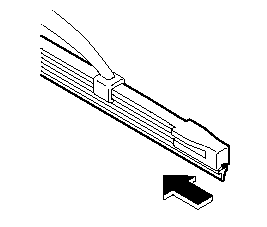Wiper Blades
CAUTION:
 Hot waxes applied by automatic
Hot waxes applied by automatic
car washers have been known to
affect the wiper's ability to clean
windows.
 To prevent damage to the wiper
To prevent damage to the wiper
blades, don't use gasoline,
kerosene, paint thinner, or other
solvents on or near them.
Contamination of either the windshield or the blades with foreign matter can reduce wiper effectiveness. Common sources are insects, tree sap, and hot wax treatments used by some commercial car washes.
If the blades are not wiping properly, clean the window and blades with a good cleaner or mild detergent; then rinse thoroughly with clean water. Repeat if necessary.
Replacing Windshield Wiper Blades
When the wipers no longer clean well, the blades are probably worn or cracked.
Replace them.
CAUTION:
To prevent damage to the wiper arms
and other components, don't try to
sweep the wiper arm by hand.

1. Raise the wiper arm and turn the blade assembly to expose the plastic locking clip.
Compress the clip and slide the assembly downward; then lift it off the arm.
CAUTION:
To prevent damage to the windshield
let the wiper arm down easily, don't
let it slap down on the windshield.

2. Hold the end of the rubber and pull until the tabs are free of the metal support.

3. Remove the metal stiffeners from each blade rubber and install them in the new blade.
CAUTION:
 Don't bend or discard the
Don't bend or discard the
stiffeners. You need to use them
again.
 If the metal stiffeners are
If the metal stiffeners are
switched, the blade's wiping
efficiency could be reduced.
So don't use the driver's side metal stiffeners on the passenger's side, or vice versa.
 Be sure to reinstall the metal
Be sure to reinstall the metal
stiffeners in the new blade rubber
so that the curve is the same as it
was in the old blade rubber.

4. Carefully insert the new blade rubber.
Then install the blade assembly in the reverse order of removal.
NOTE:
Install the blade so that the tabs are toward the
bottom of the wiper arm.
See also:
Dynamic Performance Not Found on Competitors in the Segment
Mazda focused on realizing driver-oriented maneuverability and confidence-inspiring driving dynamics for a Zoom-Zoom driving experience that is unique in this segment. At the same time, Mazda mainta ...
HomeLink Wireless Control System
NOTE:
HomeLink and HomeLink house are registered
trademarks of Johnson Controls.
The HomeLink system replaces up to 3
hand-held transmitters with a single builtin
component in the auto-dimming ...
How the SRS Air BagsWork
Your Mazda is equipped with the following types of SRS air bags. SRS air bags
are
designed to work together with the seat belts to help to reduce injuries during
an accident.
The SRS air bags ar ...


